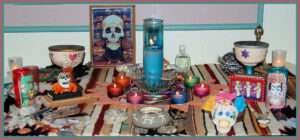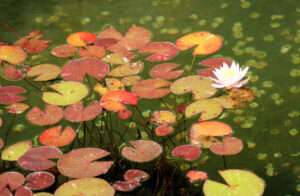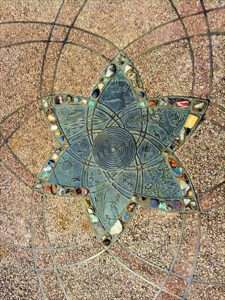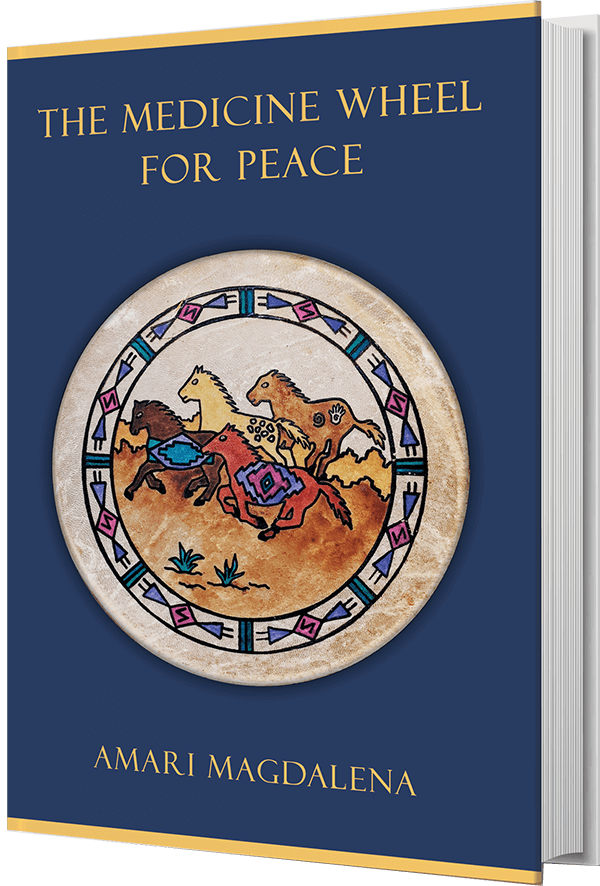Samhain and El Dia de los Muertos
by Rev. Amari Magdalena

In the center of the Kiva we placed the small items we had brought to the ceremony. Into the sipapu were entrusted articles -a letter, a locket, a snip of hair, treasures that held the energy of our dearly departed. Here the ancestors would be remembered, and released, until the next Samhain. We drummed and chanted costumed as Celtic Gods and Goddesses honoring Cerridwen Goddess of the Northwest at whose table was dispensed the elixir of knowledge, inspiration and healing of our sorrows. Reading tributes to our departed loved ones, crying, laughing, remembering, we ceremonied well into the dawning of All Saints Day. We embraced this Celtic New Year’s celebration on All Hallows Night (October 31st) with a mixture of poignant memory and celebratory heralding. And, for many of us, steeped in the blending of mixed cultures so prevalent in New Mexico, this marked the beginning of a three-day period culminating in El Dia de los Muertos: Day of The Dead on November 2nd. Weaving the Celtic, Spanish Catholic and indigenous Native people’s traditions we created a rich tapestry of cross-cultural acknowledging of Lady Death as Goddess supreme in the trinity of realities.
As summer surrenders to Autumn, the harvest is sown under, and the darkness of the cycle of contraction ensues we are gifted with ceremonies to express gratitude and to begin the seasonal cleansing that renders us fallow and receptive until the next cycle of expansion. In this void time of year, we embrace the final phase of our birth/life/death cycle. Whether our cultural foundations are more aligned with the Northern European or the colorful Mexican ceremonial milieu we can extract from their teaching a growing respect and humility for the path of the ancestors.
Samhain
Samhain (pronounced sow-in) means “summer’s end.” Drawn from the Gaelic work Samonios meaning summery, Samhain is the culmination or fulfillment of summer. Originating in Ireland the festival of Samhain was celebrated on the Eve of October 31st as a time to harvest crops and bring the herds down from the mountain for the winter. It was recognized as a magical time because the Celts believed that the boundaries between the material and spirit worlds were the thinnest. It was at this time that beloved ones who had died were honored and attempts were made to communicate with their spirits. Huge bon fires blazed to ward off “evil” spirits. Liturgically Samhain marked the beginning of the Celtic New Year. Foods, all night vigils and storytelling were proffered to deceased family members. Divining was prevalent as Celts looked ahead to the coming year. Samhain marked the cycle of entropy, descent, darkening, death and rebirth, which extended to Imbolc (approximately February 1st). The imposition of Christianity transitioned Samhain from being a time of sacrifice, communion with the dead, divination and enthusiastic feasting (in anticipation of depleted winter food reserves) to honoring Catholic Saints in the visage of All Saints Day. To avert wholesale revolt against this hindrance, Catholicism encouraged prayers and religious festivities on the eve of All Saints Day, thus evolving into All Hallows Eve or Halloween. In the 1800’s Irish immigrants brought the vestiges of this ceremony to the United States resulting in the 20th century evolution from a spiritual celebration to a commercial enterprise. In the waning days of this century as rising interest in Celtic shamanism grows, Samhain is gaining popularity as a time to honor the life cycles of birth, life ,and death. Whether Samhain is celebrated symbolically or literally, its conclusion is ultimately a reaffirmation and recommitment to life! It affords us a time to re-member and rejoin detached parts of the inner soul life with the interweaving of our ancestral heritage.
El dia de los Muertos-Day of the Dead
Dia de los Muertos—Day of The Dead is celebrated in Mexico to emphasize the positive aspects of death. Though modern celebrations of both ceremonies have Catholic overtones both view death and life as linked through spirits at the apex of a sacred trinity. In a culture (American) in which the prevailing attitudes regarding death range from mild discomfort to almost fanatical attempts to literally cover it up or bury the remains in the most expedient manner possible, death is seen as a symbol of weakness. Not so in the Latino festive adornment and homage paid to deceased family members. In fact, Mexicanos welcome the souls of the dearly departed into the world of the living. From heaven, hell, and purgatory the departed descend upon their families in joyful reunion. The dead are further animated to restore the life force and vitality known to surviving members.
Dating back to ancient civilizations such as the Aztec, the Day of the Dead was seen as a portal to other existences. Aztecs dedicated an entire month to its celebration. Festivities were presided over by the goddess Mictecacihuatl. Assimilation of the ancient traditions with the Catholicism of the Spaniards shifted the celebration to a time frame that the Spanish considered not so profane—November 1st and 2nd. With great reverence and respect the Dead are welcomed back on these two days. The 1st is reserved for children, honoring the souls of the little angelitos. On the 2nd adults who have transitioned are remembered in vigils, prayers and special feast with pan de los muertos (bread of the dead). The Calavera—the decorated skull or skeleton-is a prevalent Day of the Dead symbol reflecting the playfulness of the Dead, as they mimic the Living and dance among them. Large altars are created with momentos of the Dead. Traditional Dia de los Muertos expression celebrates life in its full embrace of death.
Dia de los Muertos celebrations can be found throughout the Southwest from Los Angeles to Phoenix to Albuquerque and elsewhere. Near Page Springs in Cornville, Arizona Huichol Marakamas (shamans) Jaichima and Vincente lead a three-day El dia de los Muertos ceremony in honor of departed souls. On unspoiled acreage at Ancient Springs Retreat Center Jaichima and Vincente teach and ceremony to restore reverence for ancient ways. Jaichima shared that “for the past 500 to 600 years since the Spaniards came our great, great, great grandfathers and grandmothers had already been participating in ceremonies of the transition (as you call it here). All of our ceremonies from way back to the Aztecs, Toltec, and Maya–we consider still with us. Death is like an entity. Death is a part of life. We call it a spiral. As you enter life, you also go out in a spiral.” She stated that three times homage is paid to the body, mind and soul in a pyramid with soul at the vertex.
Originally ceremonies were done in alignment with the harvest. As corn was cut down and ingested by humans the cycle of life and death and life was honored— “what dies, lives.” European influence brought about timing and contextual changes in ceremony for much of Mexico. The Huichol’s to this day, however, have successfully retained much of the original integrity of their ceremonies. Jaichima and Vincente invite people to join them with their candles and memories of departed and to stay up all night in prayer, chant, and soul talk honoring and paying homage.
Samhain and El Dia de los Muertos help us understand that death is not an ultimate end, but a continuous chain kept alive through remembering. We can honor our ancestors and ourselves by paying homage in a sacred way. Perhaps sentiments of both are well captured in the following lament from a Day of The Dead altar:
“We suffer three deaths.
The first one is when we die.
The second is when we are buried.
And the third, and most dreadful, is when we are forgotten.
I build my altars so that I won’t forget.”
From the altar of Ofelia Esparza




